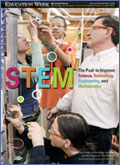Vol. 27, Issue 30
Table of Contents
Business leaders, governors, and others are urging a redoubled commitment to strengthening U.S. students’ preparation to succeed in the
subjects known by the increasingly familiar shorthand of STEM.
A special state-focused online supplement to
Technology Counts 2008. This new
State Technology Report assembles key
findings in an accessible format that allows readers to examine a particular state’s performance on this year’s indicators.
| Download a State's Detail Report: |
|
|---|
These interactive maps offer a quick way to examine state-by-state grades by categories. The grades break down into three categories:
access, capacity, and use.
Table State Technology Grades and Ranking Tables
PDF |
Excel
The interactive resource provides comprehensive data for individual states in the following categories: access to technology, use of technology, capacity of use,
state data system, and data access. Also provides ways to compare multiple states' data in all categories, as well as states' overall grades.
Unnerved by job losses, weak test scores, and competition from an increasingly skilled foreign workforce, state officials have launched a
variety of efforts to improve STEM education.
Table Math Achievement on NAEP
PDF
Table Science Achievement on NAEP
PDF
Table Progress on NAEP Math and Science
PDF |
Excel
• Where’s the 'T' in STEM?
- Experts debate whether the practical applications of math and science are getting all the attention they deserve.
A selective, specialized high school in Baltimore uses an interdisciplinary approach that enables students to experience the subjects as a
way of life.
More teacher colleges are incorporating technology education directly into math and science courses, rather than offering such training
separately.
Programs aim for growth in STEM achievement—and interest—among underrepresented groups.
• Finding Kernels of Scientific Sense
- The Cheche Konnen Center does research on improving science learning in urban communities, particularly among ethnically and linguistically diverse students.
Educators use student contests in the STEM fields to build knowledge and skills that complement the curriculum.
States vary in classroom access to computers and in policies concerning school technology.
Table Technology Leaders: Grading the States
PDF
Chart Computer Access and Tech Help
PDF |
Excel
For the Technology Leaders section of Technology Counts 2008, the EPE Research Center collected data on 14 indicators covering three major areas of state technology policy and practice: access, use, and capacity.
To assess state policy and practice in education technology, the EPE Research Center surveyed the chief state technology officials in all 50 states plus
the District of Columbia.

